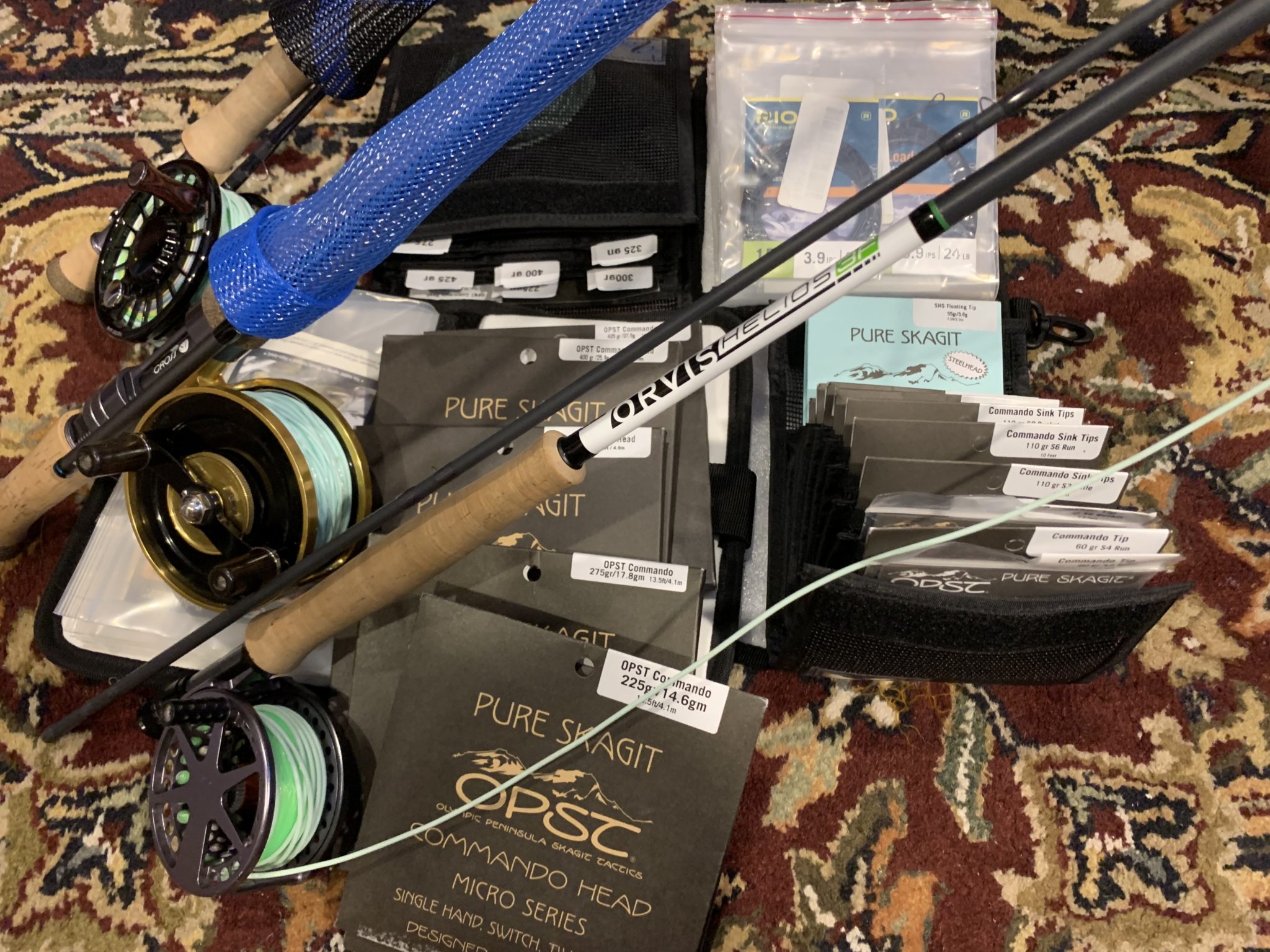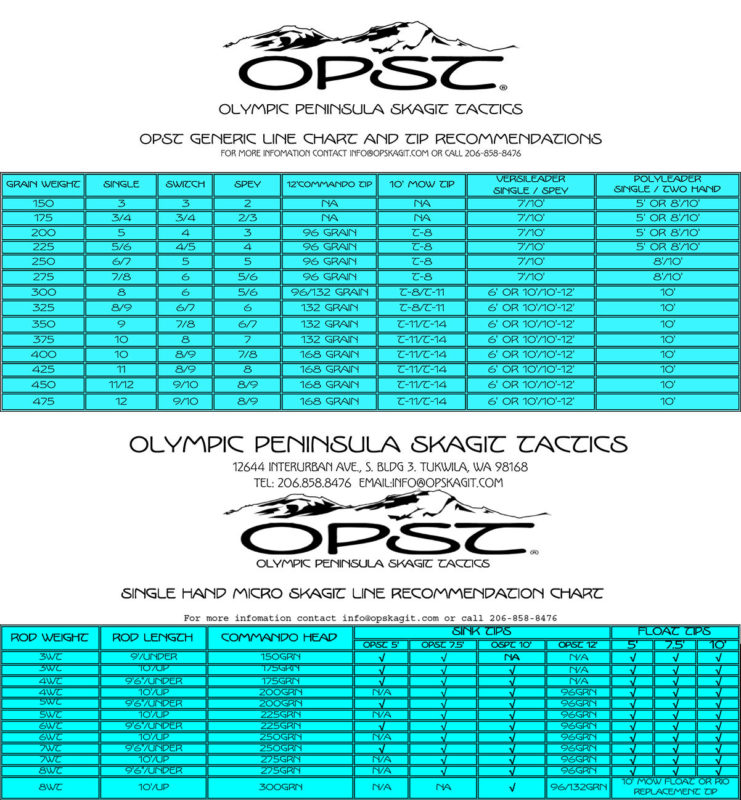
No, I’m not fishing without underwear. Im talking about a new type of Skagit Fly line by OPST called the Commando Head. Casting the commando head has radically changed my fly line preferences forever. They have especially changed the way I cast large flies, indicators, swinging patterns, and large floating poppers and flies . The benefits of learning the Commando Head system are economy of motion, longer cast with less effort, the ability to cast with no backcast room and versatility. For me, casting commando heads feel like a very familair way to cast–the basic cast is a roll cast. Perhaps it is because my home water is San Luis Reservoir where I primarily cast shooting heads. I once calculated how many casts I make a year in San Luis Reservoir. From the GoPro editing, I roughly averaged one cast every 6 minutes, aprox 10 per hour, 50 -80 per day, 200-300 a month, which was about 3000 casts a year. After 10 years, thats about 30,000 casts. Come to think of it, there is no repetitive movement that I do more of than casting a 28 foot t-14 shooting head . Today, I cast a 28 ft. 390 grain shooting head on a 9 foot, 8wgt rod with 40lb Lazer Line (mono shooting line). I water load and prefer mono to engineered shooting heads. Water loading is the act of loading the rod using the surface tension of the water in preparation for the backcast to achieve additional distance. I roll cast the line to the surface and with the line in the water in front of me, I make the backcast which loads the rod until the line pops out of the water, which in turn accelerates my backcast and loads the rod more for the forward cast . Unlike the short line Skagit cast, My fly pops out of the water and my backcast straightens out before the forward cast. The benefit of the water load is that my rod develops more load in it before I start my forward cast. My San Luis cast is a Commando Cast with a blown anchor. For me, the skill I need to master is selecting the right tip and fly weight to sustain the anchor based on the length of the rod and weight of the head. Long Leaders and heavy flies anchor more, lighter, shorter and more buoyant tips anchor less. The combination of fly leader, head density and head length controls the anchor. I the tip and leader are not tuned, it gets very difficult to sustain the anchor.
I am not good with a spey rod. In fact I think I suck at traditional skagit and spey casting. The hours I’ve spent at the Campbell Casting ponds and the the few times a year that I actually use two handed rods fishing for shad, steelhead, or salmon (or Jurassic Lake Trout in wind) casting have been meh. I do feel very comfortable with a one handed rod and I am much more comfortable casting long lines with one. The best way to learn the commando system in my opinion is to start with a one handed trout rod. Commando heads are a game change and make one handed spey casting very easy. Masterning single handed is the key to mastering double handed spey.
Modern rod and line design has led to decades of innovations in “sustained anchor casting”. All Spey casting is based on “Sustained anchor Systemology” “The Skagit cast is a water based cast with the rod load coming from the tension between the water surface and the line. This type of casting is one of the most efficient ways to cast. For old guys like me, it is also the easiest way to cast heavy lines and heavy flies long distances with economy of motion and strength especially when there is no backcast room. For me, the Commando Head Cast is actually similair to the way I cast t-14 heads striper fishing. The difference being that their is no pause in the backcast to let the line straighten and load. The Commando head Skagit cast has power throughout the cast –no pauses. Recently, two pioneer Skagit casters – Ed Ward and Jerry French –developed the OPST Commando Heads to work on virtually all types of fly rods — Two handed and single handed rods of all sizes. They make spey type casting much easier and I can use them in many local situations where there is no backcasting room. Fishing for Carp in Coyote creek comes to mind. When Fishng for trout, bass and carp. Commando lines are great for casting big flies with short light rods, indicator fishing, across and downstream dry fly fishing, Poppers and big surface flies, and swinging\stripping streamers. For Steelhead they are easier to cast than conventional spey lines and they out perform conventional line in most applications. With two handed rods, they are eaiseir to cast than longer skagit and skandi lines. I lstill prefer the full dry fly lines for finesse presentations in fresh water and salt, but for the majority of blind casting applications, its hard to beat a commando head for distance accuracy and casting efficiency. Also, as you become better with the lines, they are extremely accurate and can be used where no other line will work due to backcast restrictions.
OPST Commando Heads are optimized for shorter rods but work equally well on longer rods if they are matched by wgt to the action and length of the rod. These heads are shorter and a bit lighter than conventional Skagit lines and are designed to be cast in a different way than traditional Skagit casting. The heads are matched to tips based on the length of the rod.
I see some great applications to striper fishing San Luis. Commando Heads on a 10 ft 8 wgt would be great to throw long casts with a gurgler blind casting a shoreline. Also, a two handed rod with a heavy sink tip might be great to throw those 8 inch American Shad sized flies that Steve Santucci turned me on to. On an unrelated note, this marks the second week of waiting for the wind to die down at San Luis Reservoir. The wind prediction software has been very wrong this month.
A cheat sheet for some of my rods:
Orvis 10’ 3wt:
175 grain Commando Head,
30lb Lazar Line,
5’ 40 grain Commando Sinking Tips
7.5’ 35 grain Micro Skagit Commando Floating Tip.
7 foot Rio Versileader
Orvis 10’ 4wt:
0200 grain Commando Head,
7.5’ 60 grain Commando Sink Tips,
7.5’ 35 grain Micro Skagit Commando Floating Tip,
30lb Lazar Line.
Orvis 10’ 5wt
225 grain Commando Head
7.5’ 60 grain Commando Sink Tips,
7.5’ 35 grain Micro Skagit Commando Floating Tip,
30lb Lazar Line.
Helios 9ft 8wgt
275 grain Commando Head
35lb Lazar Line
275 grain Commando Smooth Integrated Line.
7.5’ 60 grain Commando Sinking Tips,
7.5’ 55 grain SHS Commando Floating Tips.
Winston Jungle Rod 8wgt
275 grain Commando Head
35lb Lazar Line, or
75 grain Commando Smooth Integrated Line.
7.5’ 60 grain Commando Sinking Tips,
7.5’ 55 grain SHS Commando Floating Tips.
Helios 9ft 10 wgt
325 grain Commando Head,
10’ 110 grain Commando Sink Tips,
10’ 75 grain SHS Commando Floating Tip.
Method 7126-4
425 grain Commando Head,
12’ 168 grain Commando Sink Tips
14’ 110 grain SHS Commando Floating Tip
40lb Lazar Line.
TCX 7126-4
400 grain Commando Head,
12’ 168 grain Commando Sink Tips,
14’ 110 grain SHS Commando Floating Tip,
40lb Lazar Line.
Loop Cross 7122
12’2″ 7wgt 400 grain Commando Head,
12’ 168 grain Commando Sink Tips,
14’ 110 grain SHS Commando Floating Tip
40lb Lazar Line.
Scott 11’9″ 6wgt Switch
325 grain Commando Head,
12’ 132 grain Commando Sink Tips,
12’ 90 grain SHS Commando Floating Tip
35lb Lazar Line.
Echo Beach Boost 6120
350 grain Commando ahead
12’ 132 grain Commando Tips,
12’ 9” grain SHS Commando Floating Tip,
35lb Lazar Line
Echo Boost Beach 8122
400 grain Commando Head
35lb Lazar Line,
12’ 168 grain Commando Sink Tips,
12’ 90 grain SHS Commando Floating Tip
Echo Trout Spey Glass 10’6” 4wt:
250 grain Commando Head,
10’ 80 grain Commando Sinking Tips,
10’ 50 grain SHS Commando Floating Tip
30lb Lazar Line
Winston Trout Spey 3wgt
200 grain Commando Head
35lb Lazar Line
10′ ft t-8 Rio Mow tip
10’ 80 grain Commando Sinking Tips,
10’ 50 grain SHS Commando Floating Tip



